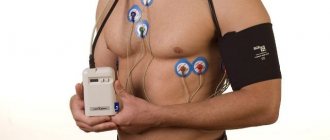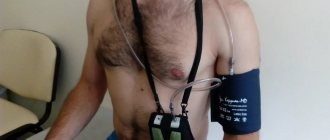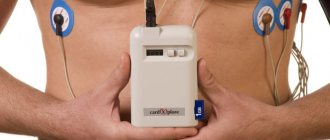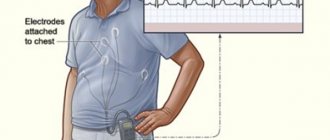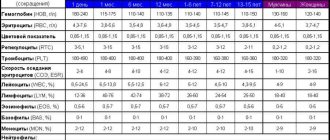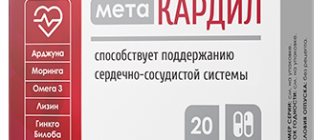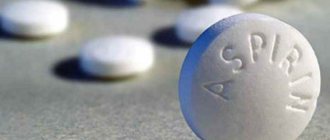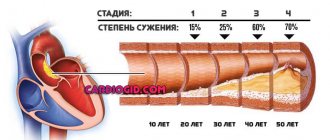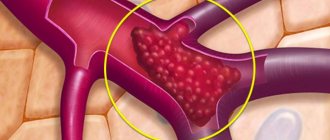24-hour Holter ECG monitoring is a popular method of comprehensive cardiac examination. Compared to an ECG, it allows you to identify changes in the functioning of the heart muscle, register all possible variants of arrhythmias, determine the impact of physical activity on the body and receive expert recommendations from a cardiologist. Daily ECG diagnostics can reveal manifestations of pathology that are not obvious at first glance and allow the initiation of effective therapy.
What is Holter
This is a method of continuously recording an ECG during normal daily activity, recording the results on a memory card and further analyzing the data obtained.
The main idea of ambulatory electrocardiography is to increase the duration and possibility of recording an ECG in the patient’s natural environment, which implies an increase in the diagnostic significance and sensitivity of the method to cardiac rhythm and conduction disturbances.
A Holter monitor is a portable cardiograph the size of a mobile phone, which is connected via wires to sensors attached to the surface of the body. This device continuously takes an electrocardiogram over a 24-48 hour interval.
In contrast to short-term ECG recording with a standard cardiograph, long-term Holter cardiac monitoring helps:
- Assess the relationship between the occurrence of arrhythmias and clinical symptoms, including syncope.
- Identify transient cardiac arrhythmias in patients with appropriate clinical symptoms.
- Register the moments of the onset and cessation of paroxysms, which makes it possible to identify the mechanism of arrhythmias and carry out differential diagnostics.
- Make a quantitative and qualitative assessment of arrhythmias necessary for risk stratification (assigning a patient to one group or another, taking into account the likelihood of complications).
- To establish the dependence of the occurrence of arrhythmias on the deficiency of coronary blood flow.
- To check the effectiveness and safety of drug therapy for arrhythmias.
- Assess the functioning of implanted devices (pacemakers, cardioverter-defibrillators).
What to pay attention to
It is important to follow several important recommendations. Avoid contact of any part of the device with water. This may cause it to break.
When performing a Holter ECG procedure during pregnancy, the patient’s movements should be careful. This is necessary so that the electrodes do not come off or become detached from the device.
It is recommended to give preference to clothing made from natural fabrics during this period. It should be free and not restrict movement.
During the study, the patient is responsible for the integrity and mechanical damage of the device.
If you need to remove the device ahead of schedule, you should not do it yourself. It is better to consult a doctor and explain the situation. During the recording period, you should not limit or change your usual routine.
To obtain reliable data, it is important not to change anything. If the patient is taking medications, there is no need to interrupt therapy.
Mechanism of operation
The result of the latest developments has been the appearance on the market of devices with multifunctional monitoring, which, in addition to the ECG, record blood pressure levels and other physiological parameters.
The mechanism of operation of 24-hour cardiac monitors is identical to an ECG device. Sensors are fixed on the patient’s body, with the help of which continuous (or episodic in case of multi-day fragmented monitoring of events) recording of the electrical activity of the myocardium occurs. Through the wires, the indicators are transmitted to the recorder with a memory card. The latest models provide online data transfer function.
Recommendations from experts
In order for a specialist to receive the most complete and accurate information, a person must behave as naturally as possible and do his usual activities.
But, nevertheless, there are a number of recommendations that the patient must strictly follow:
- the study is carried out against the background of the usual lifestyle - in order not to distort the results, it is not recommended to make any changes to the usual routine;
- the accuracy of the measurement depends on the location of the cuff - if it has moved, return it to its original position (this must be indicated in the diary);
- before starting the measurement, the device beeps - at this moment the hand must be relaxed and kept motionless until the measurement is completed (the cuff is loosened);
- it is forbidden to pinch the tube connecting the cuff and the recorder;
- It is prohibited to take a shower or bath with the cuff on;
- The device must not be wetted, cooled, or exposed to electromagnetic radiation.
Holter AD is an effective technique that allows you to establish an accurate diagnosis and select treatment that is adequate to a person’s current condition. ABPM may show an incorrect result when taking medications, the frequency and dosage of which was unknown to the specialist interpreting the results.
The Extendiagnostics clinic offers 24-hour blood pressure monitoring. If necessary, the procedure for installing the device and its subsequent removal can be performed at the patient’s home. We are always ready to meet you halfway. You can sign up for the study by calling and choosing a time convenient for you.
How does the device work and what types are there?
The Holter heart monitoring device provides:
- long-term ECG recording under conditions of the patient’s daily standard activity;
- playback of recorded signals;
- decoding and interpretation of the received data.
Most modern 24-hour ECG monitoring systems consist of:
- Recording device:
- Electrodes (sensors attached to the surface of the body).
- Connecting wires.
- Main cable.
- Pressure alarm.
- Registrar.
- Analyzing part. Software that performs system analysis of recorded data.
The recorder is fixed to the body of the subject for the entire monitoring period. The device is powered by a battery or batteries. Indicators are usually recorded on a removable storage medium (flash card).
On the body of most recorders there is an “event marker” button, which the patient presses when certain symptoms appear.
For convenience and preservation of research results, the reading part of the device transfers and converts the information contained on removable media to the analyzing element (a computer with special programs for decoding and characterizing the ECG signal).
Continuous contact of the recorder with the patient's body is ensured using disposable self-adhesive electrodes consisting of silver and chlorine alloys.
Comparative characteristics of devices for ambulatory cardiogram monitoring:
| Technology | Registration duration | Advantages of the method | Flaws |
| Holter ECG monitoring | 24-48 hours |
|
|
| Fragmented event monitoring | 1-30 days |
|
|
| External loop monitoring | 1-30 days |
|
|
| Implanted loop monitoring | Unspecified amount of time |
|
|
| Pacemaker monitoring | Unspecified amount of time |
|
|
| Hospital telemetry | 1-7 days |
|
|
| Out-of-hospital telemetry | 1-30 days |
|
|
There are also cardiorespiratory systems, in which, in addition to the ECG, sensors for monitoring respiration, oxygen in the blood, and patient movements are installed. Such a study is often carried out during sleep, and the results are deciphered by a somnologist.
Main manufacturers and their features
The leaders in the production of cardiac monitors are the UK, Germany and the Czech Republic. There are also several companies in Russia offering Holter monitors at a lower cost.
The price of the device depends on the set of additional functions, ease of use, battery and memory card capacity, as well as the duration of continuous operation, the possibility of online transmission of indicators and software for data decryption.
As is known, in some patients, episodes of arrhythmia occur rarely and it is impossible to register them during Holter. For this purpose, cardiac technology for fragmented ECG monitoring was developed. So-called “event recorders” record a short ECG episode after the device is activated by a patient who is experiencing symptoms at that time. At the end of the recording, the data is saved in memory and sent to the doctor via phone.
Comparison of the latest 24-hour ECG monitoring devices:
| Manufacturer of cardiac monitors | A country | Weight | Advantages |
| HolterLive | Germany | 38 grams |
|
| ECG Myocard-Holter | Russia, Saratov | 50-85 grams |
|
| Heaco | Great Britain | 42 grams |
|
| BTL CardioPoint | UK/Czech Republic | 106 grams |
|
| Schiller MICROVIT | Switzerland | 110 grams |
|
| Inkart | Russia | 110 grams |
|
Characteristic
Holter monitoring of the ECG of the heart involves monitoring the work of the main organ for 24 hours in a row. The portable device registers, records and transmits information in the form of an electrocardiogram to a computer, the program of which is capable of performing a daily analysis and deciphering all deviations from the norm in the functioning of the heart muscle. The Holter ECG monitoring device is also valuable because it not only accurately diagnoses cardiovascular diseases, but also improves the quality of treatment of diseases such as heart attack, myocarditis, atherosclerosis and hypertension.
In recent years, ECG Holter monitoring systems have undergone changes and improved significantly. Nowadays, the device is able to read and record many previously uncontrolled parameters of the heart. For example, in addition to rhythm disturbances, CM determines the displacement of the ST segment and performs the function of checking the operation of pacemakers and the temporal variability of heart rhythms.
It has now become known for certain that heart rhythm disturbances are a common occurrence in any person, even a relatively healthy one. Also, experts have changed the idea of the normal rhythm frequency. With the acquisition of significant experience in studies using Holter ECG monitoring, certain traditions and the need for indications for this hardware examination of patients with heart diseases have developed.
Indications for daily ECG monitoring
Continuous ECG monitoring throughout the day helps to identify the pattern of arrhythmias, their specificity, and additional phenomena that develop when normal heart rate resumes. This allows you to decide on treatment tactics.
Daily Holter ECG monitoring is indicated for:
- Complaints indicating arrhythmias (palpitations, irregular heartbeats, freezing, loss of consciousness, dizziness, chest pain).
- Stratification of the risk of life-threatening arrhythmias in patients without characteristic signs of pathology, but with:
- Hypertrophic cardiomyopathy.
- Recent acute coronary syndrome complicated by circulatory failure or arrhythmia.
- Long QT syndrome.
- Verification of the diagnosis of arrhythmia in patients with a latent course of the disease.
- The need to check the effectiveness of selected antiarrhythmic drugs.
- Assessing the functional state of an implanted cardiac device:
- In patients with complaints of heart failure.
- With individual device settings.
- Assessing insufficiency of blood supply to the myocardium in cases of suspected:
- Prinzmetal's angina.
- Acute coronary syndrome.
- Ineffectiveness of drug therapy for ischemic heart disease.
- To characterize heart rate lability in patients with diabetes mellitus and sleep apnea who have suffered acute coronary syndrome, which is complicated by heart failure, as well as to determine disorders of autonomic innervation.
- Monitoring 24-hour dynamics of the QT interval if long QT syndrome is suspected.
The most common indication for Holter is symptoms indicating arrhythmia:
- recurrent rapid heartbeat;
- dizziness;
- fainting states of unknown origin;
- periodic chest discomfort, shortness of breath, weakness.
24-hour Holter heart monitoring has no absolute contraindications.
Stages of preparation for the examination and features of its implementation
In order for the technique to show reliable results, the patient should prepare for a procedure that will last for 24 hours or 3 or more days. Before the procedure, it is necessary to take a shower, because during the examination the patient must not remove the equipment or wet it with water. You should remove metal jewelry and accessories (watches, earrings, pendants), as metal negatively affects the accuracy of cardio readings. During the procedure, you need to wear comfortable clothes, preferably cotton.
For proper operation of the device, water should not be allowed to get on the equipment; contact of the equipment with other devices that create magnetic fields around them should be avoided. You must carry the recorder carefully so as not to damage its integrity: you must not drop or hit it.
The equipment consists of 2 parts - a stationary decoder and a recording device that takes readings. The electrodes are fixed to the skin.
A full-scale heart study is carried out while the patient leads his usual lifestyle, prepares food, runs, sleeps, eats, and rests. Everything that the patient does during the monitoring process is recorded in the diary. The time spent on a specific action is recorded. You can characterize your condition using three indicators: worsened, improved, or remained unchanged.
Rules and recommendations during a Holter ECG: first, you should not exhaust yourself with physical activity, because there is a risk that the electrodes will detach from the skin and the diagnostic results will be inaccurate: second, the patient should avoid stressful situations; third, it is undesirable to travel, fly on an airplane or go on attractions during the examination; fourth, the device should not be exposed to strong temperature changes; fifth, you should protect the recorder from moisture and water.
The patient should lie on his back so that the location of the electrodes is not disturbed. If your back hurts, you can turn over on your side, but at the same time monitor the operation of the device. This technique is considered safe; it does not cause complications or pathological changes. Cardiac registration should not be prescribed to people with high blood pressure, left ventricular diastolic dysfunction, organ dysfunction, acquired heart defects, asymptomatic myocardial ischemia, angina pectoris (chest discomfort).
Best materials of the month
- Coronaviruses: SARS-CoV-2 (COVID-19)
- Antibiotics for the prevention and treatment of COVID-19: how effective are they?
- The most common "office" diseases
- Does vodka kill coronavirus?
- How to stay alive on our roads?
Rules for performing the examination
Before starting the study, the patient becomes familiar with the following information:
- date and time of the next visit to remove the device;
- rules for keeping entries in a diary;
- cases of using a push-button analyzer;
- prohibition of bathing and the use of electrically heated bed linen;
- prohibition on self-configuration of the registrar;
- constant monitoring of the position and contact of sensors, wires and timely restoration of normal operation of the device.
If there is excessive hair growth on the skin of the subject where the sensors are planned to be applied, it must be removed. Then the skin is treated with isopropanol or acetone and wiped with a special sponge or abrasive paste to completely degrease. This reduces skin resistance, which improves recording quality and prevents electrode lag during physical activity. After gluing the sensors, check their resistance (no more than 8 kOhm).
The electrodes are connected to the recording device using wires 85-95 cm long. Then they are fixed on the patient’s skin with a plaster, twisting it into a loop (better shock absorption during movements). During the hot season, the sensors are secured with double the amount of plaster. While sleeping, the subject wears tight underwear.
Sensors are usually placed on areas of the body with a small volume of muscles to avoid artifacts and signal distortion during active movements.
After installing the device, a functional test is performed to determine the reliability of contact of the sensors with the skin. To do this, an ECG recording is displayed on a computer monitor while the patient changes the position of the body in space.
Then a power source is inserted into the recording device, which is placed in a case and attached to the belt.
How long does the monitor last and what are 12 channels?
Since the wearable recorder has an autonomous power source, the length of time the monitor is worn, the number of electrodes used, and the abundance of ECG abnormalities (artifacts) during continuous recording affect battery depletion. As a rule, during the initial assessment, cardiologists record up to 12 channels (12 channels are a simulation similar to a regular ECG) with a wearing period of 1 to 2 days, if necessary.
It is clear that multi-day recording, in order to prevent premature discharge of the power source, is carried out with a limitation on the number of recorded channels, which does not reduce the value of the study for arrhythmias, but limits the possibility of assessing ischemia.
The practice of the A-Media Family Clinic, with multi-day recording in the case of a more thorough search for ischemia, has developed a rule for recording all 12 ECG channels with the patient coming to the Center every 1-1.5 days to view the recording and resume the battery operating mode.
Keeping a patient diary
During the period of daily Holter ECG monitoring, the patient is required to keep a diary, where the necessary fields must be filled out in detail.
This document consists of two halves:
- Part A, where the patient indicates:
- Type of activity (sleep, walk, physical work, driving, stress).
- Signs of pathology (pain, heartbeat, shortness of breath, chest tightness, dizziness, sudden weakness).
- Time of medication use (name and dose).
- Hours of start and end of activity and complaints (from – to).
Example:
| Time | Occupation | Signs of the disease |
| 10:00-12:00 | Walk in the park | Chest pain |
- Part B (the patient fills out only for chest pain):
- Character (dull, pressing, stabbing).
- Time of occurrence (rest, work, stress, sleep).
- The intensity of pain decreases on its own (when), after stopping the load, taking nitrates.
Additionally, on the model of the torso, the patient indicates the localization of pain.
How should you prepare for a HM study?
All equipment is protected from interference and does not require any special restrictions, except for the patient’s clothing. Here we recommend that during the period of the study you wear underwear that does not cause static electricity - without wool and synthetics, optimally cotton and linen. Women should wear short shirts when installing a monitor with an external cable and a bag. On the contrary, a “wireless” monitor does not limit the length of clothing. When installing a blood pressure monitor, outerwear should not have tight sleeves. Men with thick chest hair should not shave it themselves; we will do this during placement.
The specifics of the study, medications, and proposed samples will be brought to your attention when installing the monitor.
